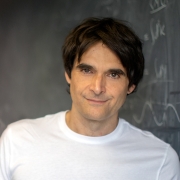Dark Energy Survey Offers New View of Dark Matter Halos
Dark matter, a mysterious form of matter that makes up about 80 percent of the mass of the universe, has evaded detection for decades. Although it doesn’t interact with light, scientists believe it’s there because of its influence on galaxies and galaxy clusters.
It extends far beyond the reach of the furthest stars in galaxies, forming what scientists call a dark matter halo. While stars within the galaxy rotate in a neat, organized disk, these dark matter particles are like a swarm of bees, moving chaotically in random directions, which keeps them puffed up to balance the inward pull of gravity.
Previous research led by postdoctoral fellow Eric Baxter; Bhuvnesh Jain, Walter H. and Leonore C. Annenberg Professor in the Natural Sciences in the Department of Physics and Astronomy; and Chihway Chang of the University of Chicago provided evidence that dark matter halos around galaxy clusters have an edge due to the “splashback effect.”
“You have this big dark matter halo that surrounds every galaxy cluster,” Baxter says, “and it's been accreting matter gravitationally over its entire history. As that matter gets pulled in, it goes faster and faster. When it finally falls into the halo, it turns around and starts to orbit. That turnaround is what people have started calling splashback, because stuff is splashing back in some sense.”
Click here to read the full story.





